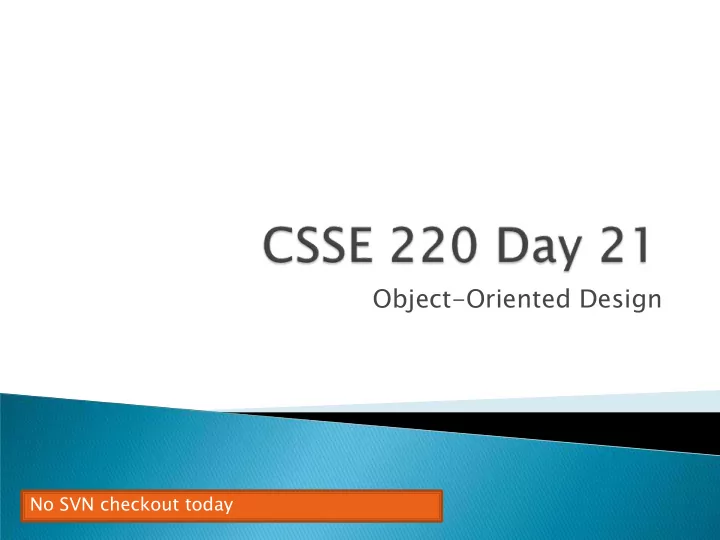

Object-Oriented Design No SVN checkout today
Software development methods Object-oriented design with CRC cards LayoutManagers for Java GUIs BallWorlds work time
Analysis Design Software Implementation Development Testing Deployment Maintenance
Standardized approaches intended to: ◦ Reduce costs ◦ Increase predictability of results Examples: ◦ Waterfall model ◦ Spiral model ◦ “Rational Unified Process”
Do each stage to completion Analysis Then do the next stage Design Implementation Testing Pipe dream model? Deployment
Schedule overruns Scope creep Repeat phases in a cycle Produce a prototype at end of each cycle Get early feedback, incorporate changes Prototype Deployment
Like the spiral model with ve very short cycles Pioneered by Kent Beck One of several “agile” methodologies, focused on building high quality software quickly Rather than focus on rigid process, XP espouses 12 key practices…
Realistic planning Pair r program ammi ming ng Small releases Collective ownership Shared metaphors Continuous integration Simplicity 40-hour week Testing ng On-site customer Refactor toring ing Coding ng standar ards ds When you see Use descriptive opportunity to make names code better, do it Q1
A practical technique
We won’t use full -scale, formal methodologies ◦ Those are in later SE courses We will practice a common object-oriented design technique using CRC Cards ds Like any design technique, the key to success ess is practi tice ce
1. Discover cover classe sses s based on 1. requirements 2. Dete termine mine respon onsibi sibilities lities of 2. each class 3. Des escribe ribe rel elationships tionships between 3. classes Q2
Brainstorm a list of possible classes ◦ Anything that might work ◦ No squashing
Prompts: Tired of hearing this yet? ◦ Look for nouns ns ◦ Multiple objects are often created from each class So look for plural al con once cepts pts ◦ Consider how much detail a concept requires: A lot? Probably a class Not much? Perhaps a primitive type Don’t expect to find them all add as needed
Look for ve verbs in the requirements to identify resp sponsib onsibili liti ties es of your system Which class handles the responsibility? Can use CRC RC Cards ds to discover this: ◦ Cla lasses ses ◦ Responsi onsibil biliti ities es ◦ Coll llabora orators rs
Use one index card per class Class name Collaborators Responsibilities Q3
Pick a respons ponsibi ibili lity ty of the program 1. Pick a class to carry out that responsibility 2. Add that responsibility to the class’s card ◦ Can that class carry out the responsibility by 3. itself? Yes Return to step 1 ◦ No ◦ Decide which classes should help List them as colla laborator orators on the first card Add additional responsibilities to the collaborators’ cards
Spread read the cards s out on a table ◦ Or sticky notes on a whiteboard instead of cards Use a “token” to keep your place ◦ A quarter or a magnet Focus us on high gh-level level respons ponsibi ibilit ities ies ◦ Some say < 3 per card Kee eep p it informal mal ◦ Rewrite cards if they get too sloppy ◦ Tear up mistakes ◦ Shuffle cards around to keep “friends” together
These go to 11
Classes usually are related to their collaborators Draw a UML class diagram showing how Common relationships: ◦ Inheri eritance tance: only when subclass is a special case ◦ Ag Aggr gregation egation: when one class has a field eld that references another class NEW! ◦ Dependency endency: like aggregation but transient, usually for method parameters, “has a” temporarily ◦ As Associ ociation ation: any other relationship, can label the arrow, e.g., construc structs ts
Q4
Draw UML class diagrams based on your CRC cards Initially just show classes (not insides of each) Add insides for two classes
When JFrame’s and JPanel’s defaults just don’t cut it.
Answer: 5 We use the two-argument version of add : JPanel p = new JPanel(); frame.add(p, BorderLayout.SOUTH); JFrame ’s default LayoutManager is a BorderLayout LayoutManager instances tell the Java library how to arrange components BorderLayout uses up to five components Q5
Answer: arbitrarily many Additional components are added in a line JPanel ’s default LayoutManager is a FlowLayout
We can set the layout manager of a JPanel manually if we don’t like the default: JPanel panel = new JPanel(); panel.setLayout(new GridLayout(4,3)); panel.add(new JButton("1")); panel.add(new JButton("2")); panel.add(new JButton("3")); panel.add(new JButton("4")); // ... panel.add(new JButton("0")); panel.add(new JButton("#")); frame.add(panel);
A LayoutManager determines how components are laid out within a container • BorderLayout . When adding a component, you specify center, north, south, east, or west for its location. (Default for a JFrame.) • FlowLayout : Components are placed left to right. When a row is filled, start a new one. (Default for a JPanel.) • GridLayout . All components same size, placed into a 2D grid. • Many others are available, including BoxLayout , CardLayout , GridBagLayout , GroupLayout • If you use null for the LayoutManager , then you must specify every location using coordinates More control, but it doesn’t resize automatically Q6
Chapter 18 of Big Java Swing Tutorial ◦ http://java.sun.com/docs/books/tutorial/ui/index.html ◦ Also linked from schedule
BallWorlds Q7-Q8
Recommend
More recommend